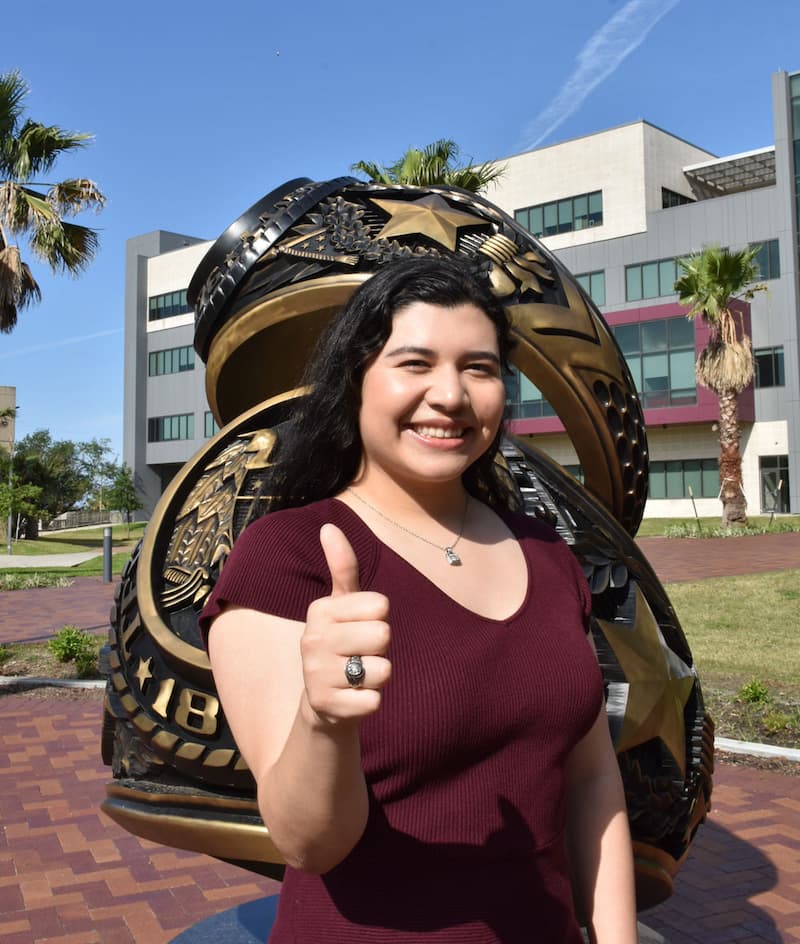Overcoming the Odds: Gema Garcia
June 6, 2023
Tweet
By Taylor Bounds, Content Specialist
Graduating from college is a momentous milestone, and most students face challenges on the path to their degree. For Gema Garcia ‘24, who received her Aggie Ring in April and plans to graduate next May, the path has been steeper than most.
Garcia first started experiencing aura seizures in high school. When other treatment options ran out, she and her family decided surgery was the right approach. Shortly after the death of her father, she underwent brain surgery. Her recovery was relatively simple, and though she still had seizures, Garcia soon returned to her normal life, and was seizure-free for nearly three months. She graduated high school the following spring and enrolled at Texas A&M University at Galveston.
However, because Garcia’s seizures started again, after the first semester of her sophomore year, she returned to Memorial Hermann Children’s Hospital to undergo her second brain surgery. Doctors explained that recovery would be different this time and she would lose part of her field of vision. But when she woke, she discovered she wasn't able to walk, use her left hand or carry on a conversation. Garcia said this time was both physically and emotionally painful, and she became incredibly busy with physical, occupational and speech therapy.
"They would show me a picture of an oven, and I knew what it was, and I knew what it did, but I just couldn't tell you what it was called," said Garcia. "At first, I was worried I wouldn't be able to return to school, I couldn't even imagine how long it was going to take for me to regain mobility, and there was a lot to do before I could think of the possibility of returning. It took a lot of effort."
Garcia's second surgery took place during the height of the COVID-19 pandemic and the hospital was largely locked-down. She explained that she was immensely grateful to be a patient in the pediatric unit, which treats young adults in addition to young children, because her mother was able to stay with her while she was isolated. Having a family member with her immediately following surgery was especially helpful while she was unable to advocate for herself. Through extensive therapy, she regained her ability to walk and improved her speech and motor skills in her left hand. She was able to walk out of the hospital on her own.
Eventually, she started a therapy program at Texas Institute for Rehabilitation and Research Memorial Hermann (TIRR), where she participated in the TIRR Challenge University. Surrounded by other people facing similar challenges and with the encouragement from the TIRR team, she was determined to be able to run again. This program was special: she was with other college students, and the environment of an outpatient clinic allowed her freedom she hadn't had while hospitalized. With the support of group sessions, including one specifically for college students called TIRR University, she became comfortable and quickly found herself continuing to improve.
With her health goals at the front of her mind, she successfully completed the challenge. While she planned to return to Texas A&M-Galveston soon after surgery, after a month-long stay in the Memorial Hermann Children’s Hospital and another month at TIRR Rehabilitation Memorial Hermann Hospital, she decided to take courses at Lone Star College upon completion of the TIRR Challenge.
After a fall down the stairs, Garcia wanted to revisit the TIRR Challenge to continue building her stability and movement skills. This time, she joined a group for women, a group called “Brain Works” designed for those with brain injuries, a physical therapy group called “Live Group” and participated again in Challenge University. She continued to see improvements in her speech and her hand. Although both experiences at TIRR were stressful, Garcia says she is very thankful for everyone there who helped her along her journey.
Once she completed her second successful TIRR challenge and received her associate's degree at Lone Star College, Garcia returned to Aggieland by the sea in the fall of 2022.
Now, Garcia is highly involved on campus as a Terry Scholar, a member of the Student Association of Latino Leaders (SALL) and Catholic Sea Aggies. They are an outlet for her to continue her long history of volunteer work, which she says started in the ninth grade. Through SALL, she learns about different Latin cultures and particularly enjoys listening to speakers. As an active member of the Catholic Sea Aggies, she says that her faith helped her through her recovery.
Though she originally studied marine biology, she changed her major to maritime studies upon her return to Texas A&M-Galveston. Garcia says that her degree in Maritime Studies allows her to "explore the importance of international policy and culture." Recently, she completed a research project about the impact of fast fashion on human rights and the harm it's causing to the environment. What she discovered through this project was deeply alarming: extremely hazardous working conditions for garment workers in China, toxic clothing, and that in just the United States alone, there are about 34 billion pounds annually of textile waste, fueled almost entirely by fast fashion.
Now seizure-free and with graduation in her sight, she is particularly interested in nonprofit or policy work in the environmental sector and considering graduate school. With her work ethic and dedication, there is no doubt that Garcia's future has unlimited potential.
###
Media contact:More:
Read more about Arts & Humanities
Read more about Business, Law & Society
Read more about Liberal Studies
Read more about Student Life